Leave & Absence
1. Overview
2. Leave Summaries
3. Rollout Leave Entitlements
4. Carry Forward Leave Entitlements
5. Edit Leave Entitlements
6. Ad-hoc Absences
7. Record Leave
8. Modification of a Leave Request
9. Business Closures
10. Leave block
11. Automation
1. Overview
Leave Management is a very comprehensive area in Dynamics HR Management. Therefore, you first get an overview of what is possible, where the similarities and differences between the individual functions lie, and finally a detailed guide on how to use the functions effectively.
A distinction is made between Ad Hoc Absences and Planned Absences. Planned absences include vacation and overtime, while ad hoc absences are unplanned and unexpected, such as sickness or a work accident.
A distinction is also made as to whether the absence can also be requested by the employee, such as leave, or whether it can only be entered by the HR Manager, such as unexcused absences.
In addition to the absences of individual employees, HR Managers also have the option of rolling out and automatically approving absences for several employees, individual departments, or even for the entire company. This option is used for business closures, for example.
However, you can not only enter absences for employees, but also block absences for certain employees in certain periods. You could use this, for example, if important tasks are due for which certain persons are absolutely necessary.
As soon as you manage absences, many recurring tasks occur automatically in the background, without you having to repeat them manually. You can find a more detailed overview of this below: Automation
1.1 Explanation of the Offset Functionality
Offset between positive and negative remaining Leave Entitlements possible
The solution supports offsetting leave entitlements. On creation or update of the leave entitlement's amount or taken value, the system checks if there is a leave entitlement to be offset. Offsetting a leave entitlement means balancing out negative remaining leave entitlements with positive existing leave entitlements.
For example, if an employee overbooked his leave entitlement and later receives a new leave entitlement, or if a negative remaining entitlement was carried forward to the next fiscal year, the new leave entitlement would first be used to offset the negative entitlement and then the remaining entitlement can be used for requesting leave. The offset is handled via a new entity "Leave Entitlement Offset" which connects two leave entitlements. The amount on the leave entitlement offset is taken from "Offset From" and given to "Offset To". Leave entitlements which are created to book out a positive remaining entitlement after the end date of a leave entitlement are not offset. In order to ensure this a flag is used in the background to highlight that it is booked out. Records with a flag set to "Yes" are neither considered for leave entitlement offset, nor for connecting to a leave allocation. The record is only related to the parent leave entitlement where it is booked out from.
Overbooking of Leave Entitlements possible
A leave entitlement record can no longer be overbooked. In case an employee's leave request is approved exceeding the amount of leave entitlements, the overbooked days will be collected in a dedicated entitlement. This means that a leave allocation is created for a new leave entitlement with the amount of zero for every overbooked leave request. This leave entitlement has the start date equal to the start of the leave request. The automatically created leave entitlement for overbookings is by default valid until the end of the fiscal year and set to "Transfer To New Period" as the process remaining. The "Transfer Until" date (formerly called "Expiry Date") is by default the end of the next fiscal year but can be changed.
1.2 Use Case
Case 1: Overbooking a leave Entitlement
The employee Anna Smith has a leave entitlement for the absence type Vacation for 28 days for the current year 2020. For this year she plans to go on a long summer holiday overseas. Therefore, she makes a leave request from 1 July 2020 to 9 August 2020 which uses up her whole vacation entitlement of 28 days. While she is on holiday her flight back home gets cancelled and the next flight is only available in 5 days. Therefore, she has to extend her vacation. Her HR Manager approves the request. Now Anna has taken 33 days of leave and her leave entitlement with 28 days is overbooked by 5 days.
What happens to Anna's leave summary?
Before this Roll Up 31, the "Taken" value of the entitlement was updated to 33 days and the "Remaining" value was updated to 5 days negative.

With the new update, the leave summary looks like below. As you can see, the vacation entitlement with 28 days is not overbooked anymore. It is only A new entitlement with 0 days containing the overbooked amount of days is created automatically. Also, this means that a leave allocation is created for every overbooked leave request that automatically creates a new leave entitlement with the amount of zero.

To find out how offsetting a negative leave entitlement with an additionally granted entitlement works, please go to Case 1a. To find out what a case looks like when the negative leave is carried forward to the next fiscal year, please refer to Case 1b.
Case 1.a: Offsetting a negative leave entitlement with an additional entitlement
After Anna is back from her holiday she has her annual performance review in autumn. In order to acknowledge her hard work, Anna's HR Manager grants her an additional 6 days of vacation. As she still owes the company 5 days from her prolonged summer holiday, she does not receive the full entitlement of 6 days. The new entitlement immediately gets offset against the negative remaining entitlement. Therefore, only one day that is leftover remains as vacation entitlement available for Anna to use.

Case 1.b: Offsetting a carried forward negative leave entitlement with newly rolled out annual leave
For her prolonged summer holiday, Anna owes the company 5 days of leave. As explained above, this entitlement is set to "Transfer To New Period", so it will get carried forward to the next fiscal year 2021. At the beginning of the next fiscal year, her new annual leave entitlement of 28 days of vacation is rolled out. However, because she still owes the company 5 days from the year 2020…

… this entitlement will be carried forward and get offset against her newly rolled out annual leave entitlement of 28 days. As the negative leave is immediately deducted from her new positive entitlement, she can only use 23 days of vacation in 2021. This is what the leave summary looks like:

As you can see, the positive entitlement of 28 days is used as "Offset From" and balances out Anna's negative remaining days.
Back to top | Back to table of contents
2. Leave Summaries
You can get an overview of all employees' leave summaries.
Navigate to HR Hub - Leave Summaries (Leave & Absence).

This overview provides you with detailed information on all employees and their absences.
You can see how much leave entitlements an employee has for which absence type, how much of this entitlement has already been used, and how long the remaining entitlement calculated from this is still valid.
The entitlements, as well as their validity, are automatically transferred from the employment contract. All absences already taken are transferred from the absence management.
Planned absences are displayed in the leave summaries overview as soon as they are approved. Ad-hoc absences are taken over directly.
An individual data record is displayed for each employee per absence type in the leave summaries overview.
Special Feature - Overtime
Overtime is a special feature. The total overtime is constantly updated and receives the data from the presence of each employee. In this way, a new entitlement is created for each day on which overtime was worked. This is added to the total entitlement in each case.
You can find more information here: How much overtime have I worked?
Besides regular leave, overtime is the only absence type that can also be requested in Self-Service.
You also have the possibility to extend or customize this view.
Back to top | Back to table of contents
3. Rollout Leave Entitlements
The rollout of leave entitlements is an easy process and can be performed by using a dialogue.
This dialogue affects all employees of a department and the employees of the departments that are hierarchically beneath.
For detailed information on how to use the dialogue, please follow this link: Rollout Leave Entitlement
Back to top | Back to table of contents
4. Carry Forward Leave Entitlements
You can carry forward remaining leave entitlements of your employees with an easy to use dialogue.
The most time saving way is to carry forward the remaining leave entitlements for a whole department or even the whole company at once.
If you want to carry forward the remaining leave entitlement of a single employee, open his Digital Personnel File and click Carry Forward Leave Entitlement in the navigation bar.
For detailed information on how to use the dialogue, please follow this link: Carry Forward Leave Entitlement
Back to top | Back to table of contents
5. Edit Leave Entitlements
You may need to change an employee's leave entitlement afterwards. It does not matter whether you want to deduct entitlement or grant a new entitlement. However, you do not have to immediately renew the current employment term with the entitlements for this purpose.
To change an employee's leave entitlements, open the employee's Digital Personnel File by navigating to HR Hub - Employees and double-clicking to open your employee's entry.
witch to the "Leave & Absence" tab. On the right side you will see the leave summaries of your employee. Here you can add a new leave entitlement by clicking on the "Add Leave Entitlement" button.
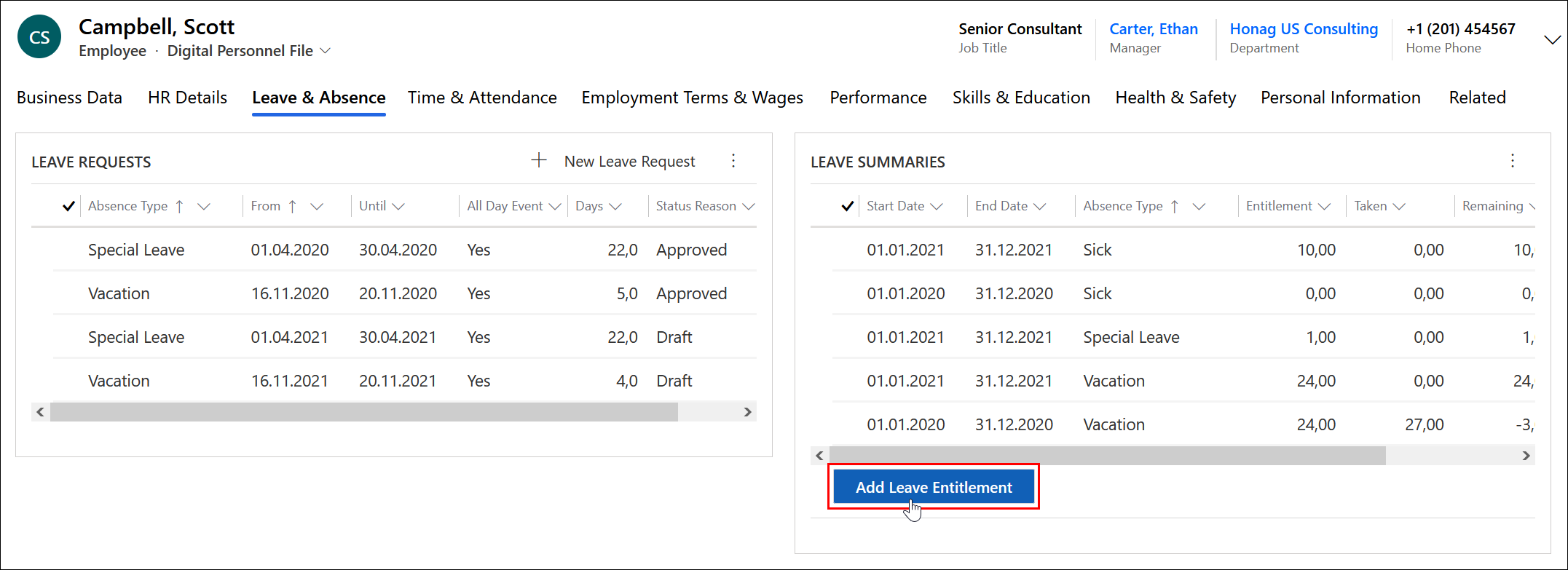
A dialog opens. Now choose the absence type, as well as the entitlement amount you want to add or subtract. The value for the entitlement is specified in days. Valid are whole and half days.
Select the start and end dates for the validity period and, optionally, the date up to which the entitlement should be transferred.
Now define what should happen to remaining entitlement and optionally specify a description for the leave entitlement.
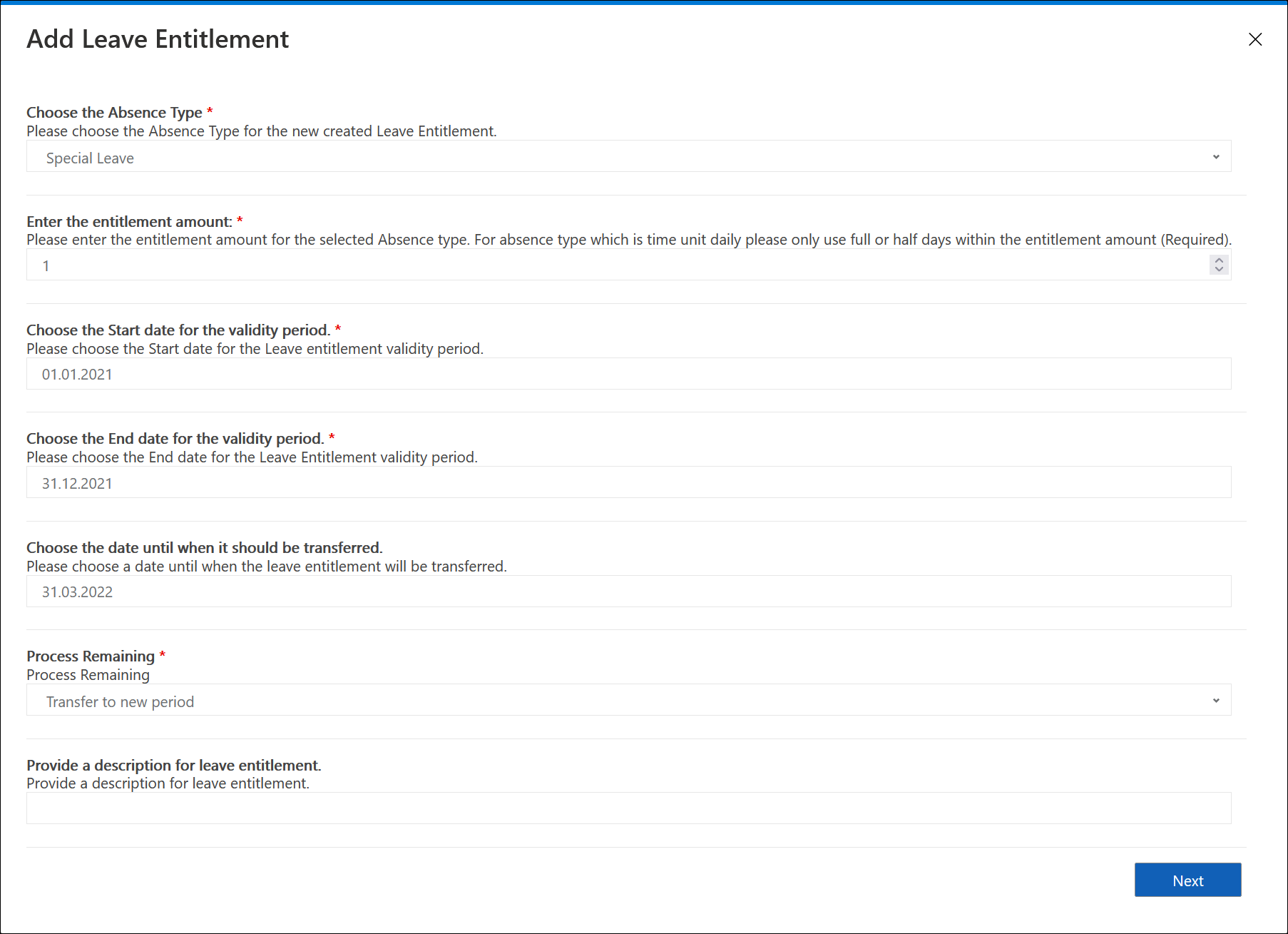
Click Next. The leave entitlement will now be added or deducted according to your defined entries.
You can close the dialog. Please refresh the page.
Back to top | Back to table of contents
6. Ad-hoc Absences
Ad-hoc absences can be recorded by HR managers or supervisors using the Digital Personnel File.
Open the tab "Leave & Absence" within the digital personnel file of the employee. In the "Leave Requests" and "Sick Leave Requests" sections, you can add a new absence by clicking on "New Leave Request".
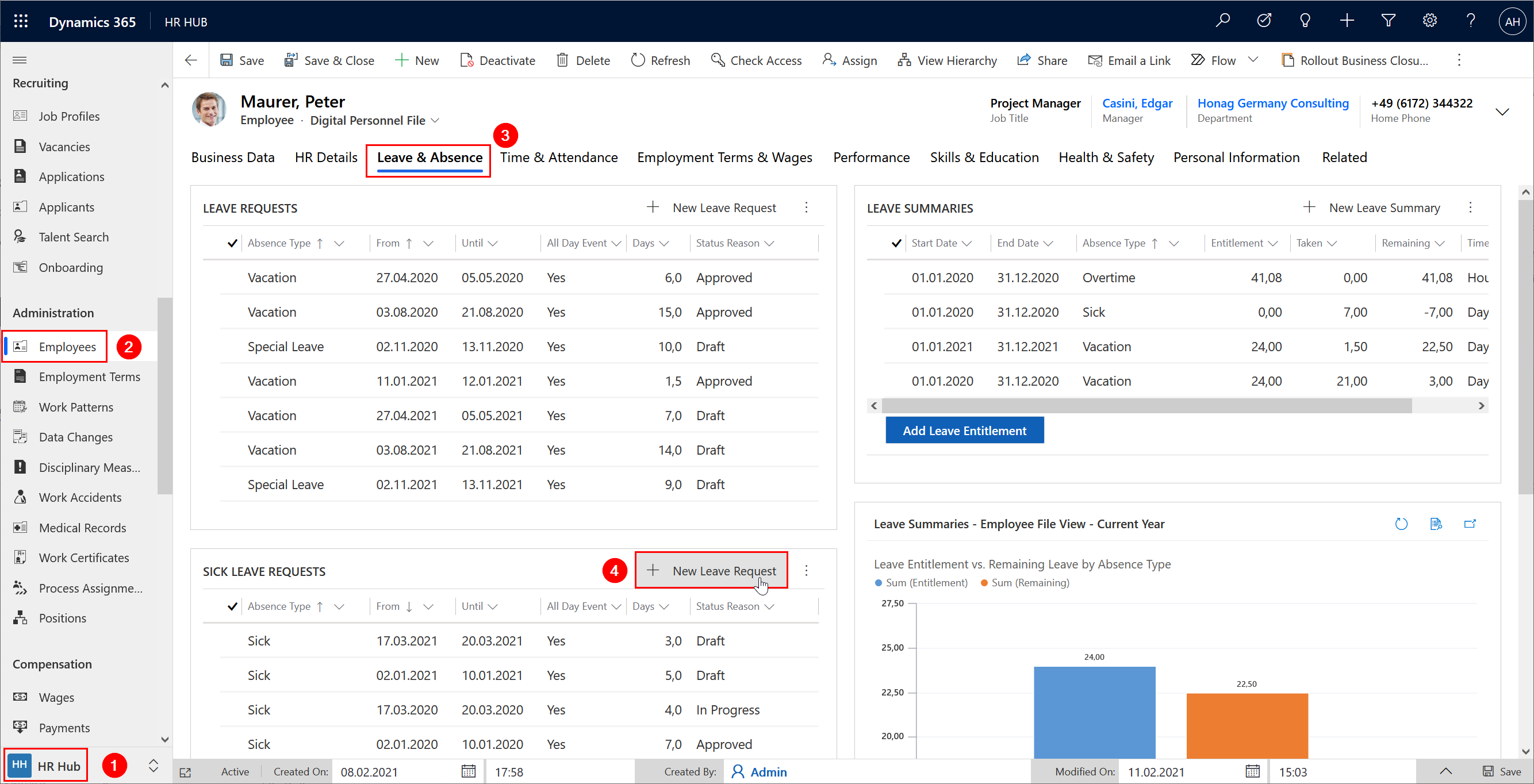
The process for a new leave request opens. The name of the employee is already taken over from the digital personnel file.
Now select the Absence Type and define the fields From (start date) and Until (expected end date). If necessary, you can also set if this absence is an all-day event or only half of the day.
Click on Submit.
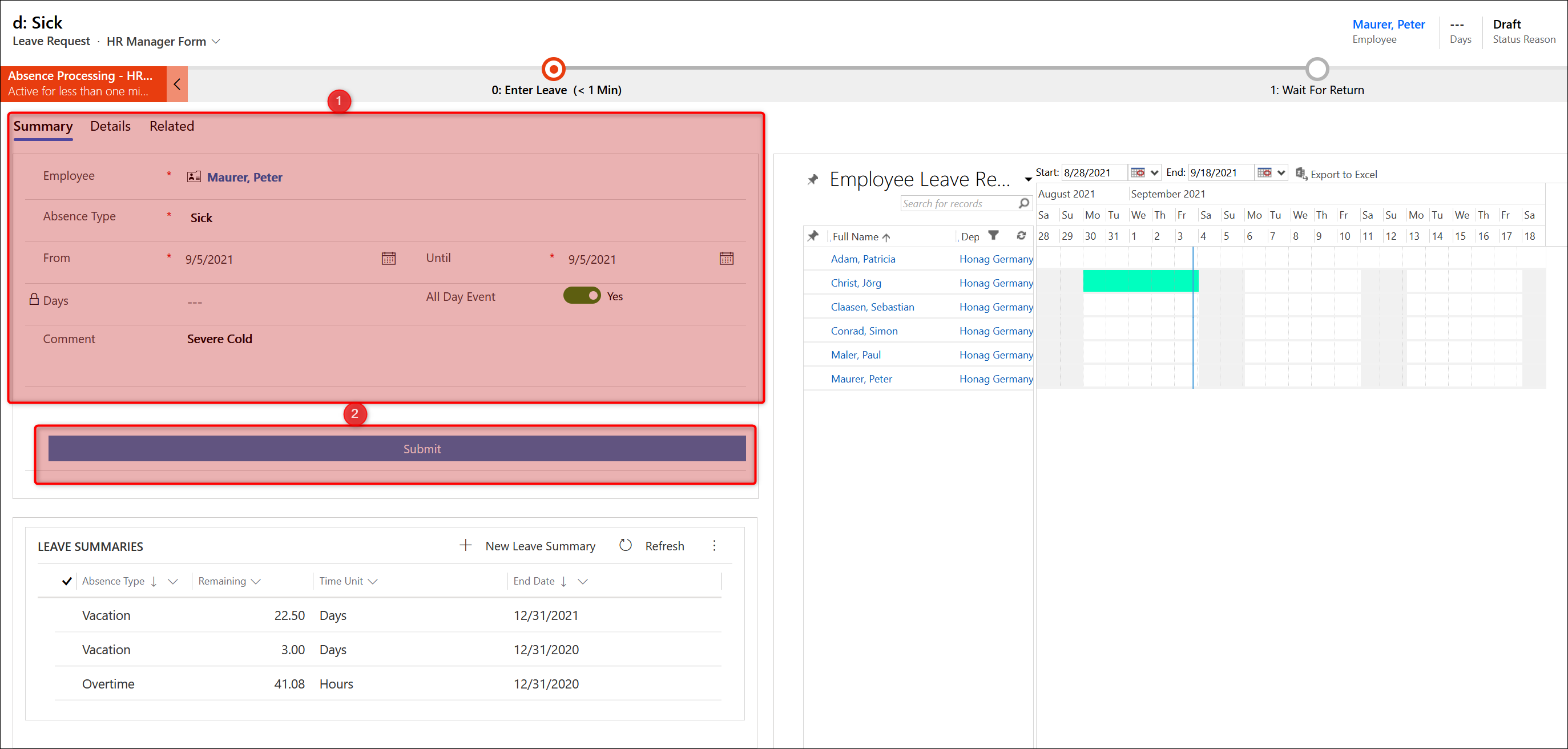
After the first saving, the absence days are calculated automatically, the department calendar is loaded and the absence is visible in the status reason "Draft". In this way, it is easy to see whether the employee's absence may lead to any capacity bottlenecks.
Click on Submit.
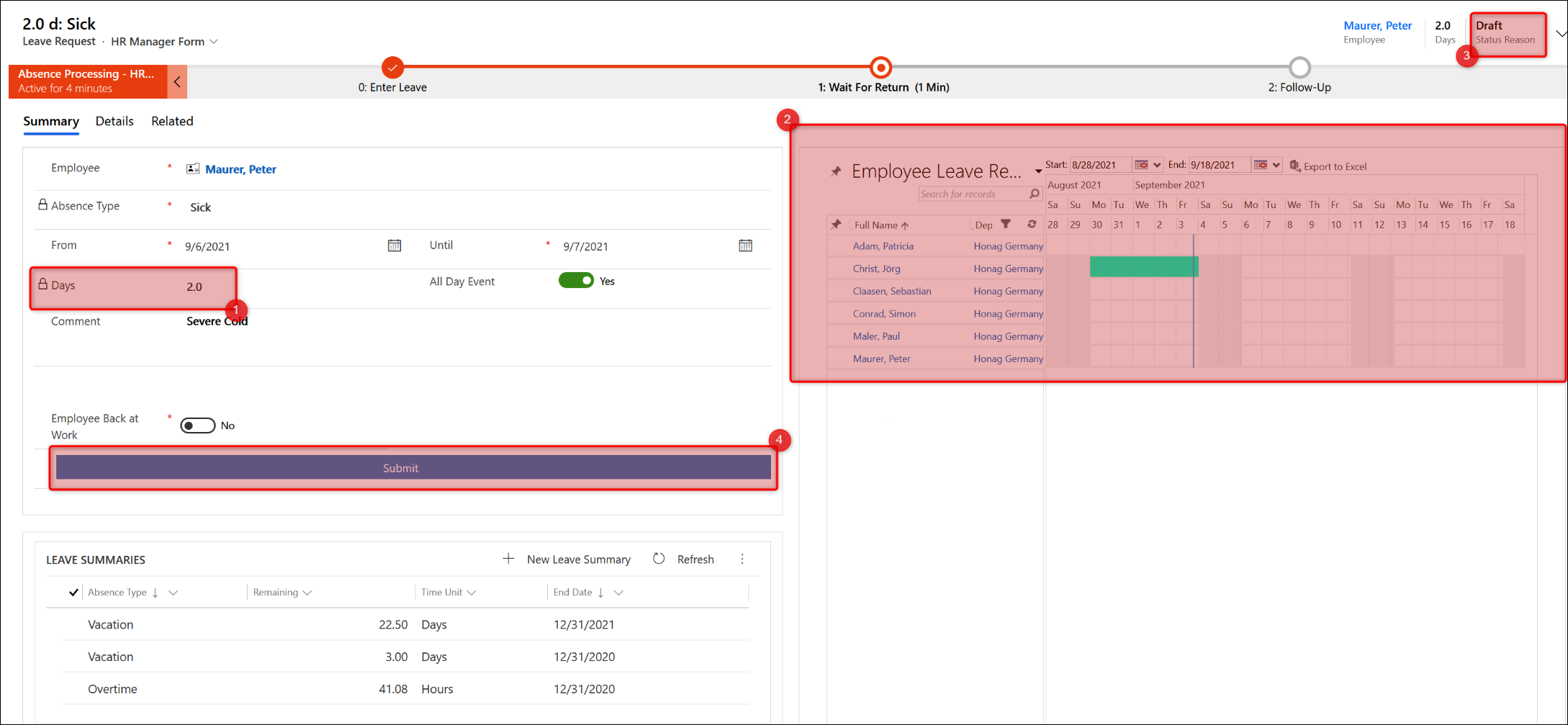
The record remains in this phase until the employee returns to work. If necessary, the expected end date (Until) can always be updated during this time. Once the employee has returned, the end date can be finally adjusted and the field "Employee Back at Work" can be set to "Yes". Depending on the duration and type of absence, the Follow-Up phase is added.
Click on Submit.
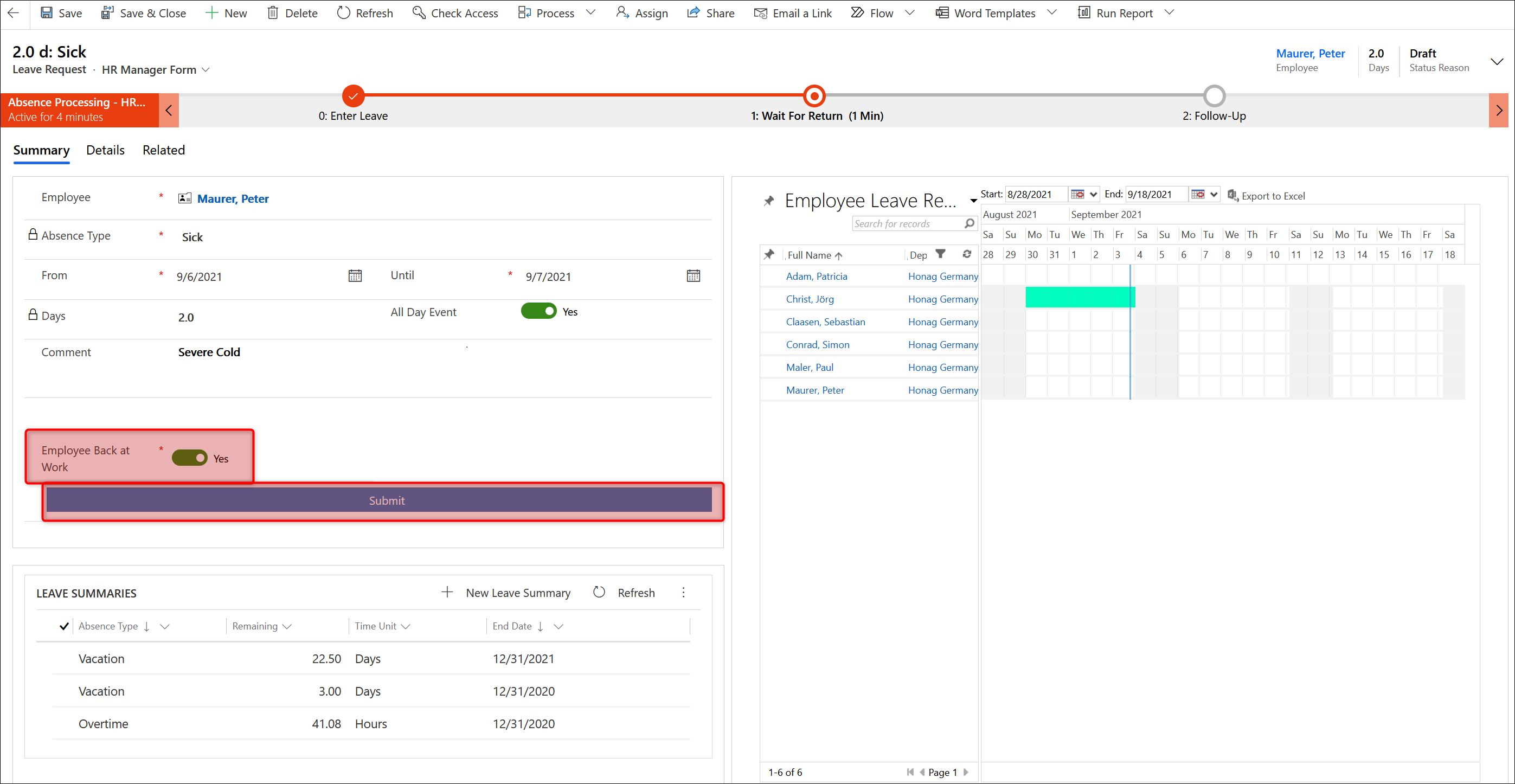
In the last step, you can now indicate whether any necessary sick note has been received. In this case, set the field "Sick Certificate Received" to "Yes" and click on Save.
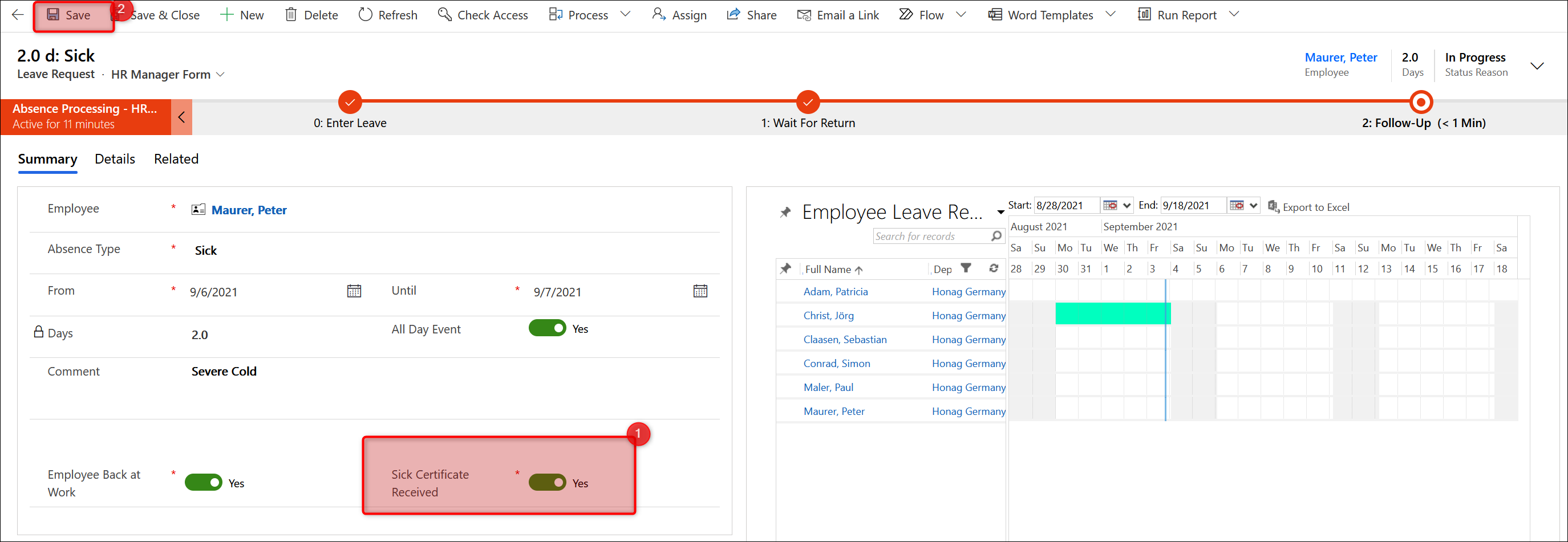
The status reason changes to "Approved" and the record is saved as read-only. In addition, an entry appears in the leave summary and in the absence calendar.
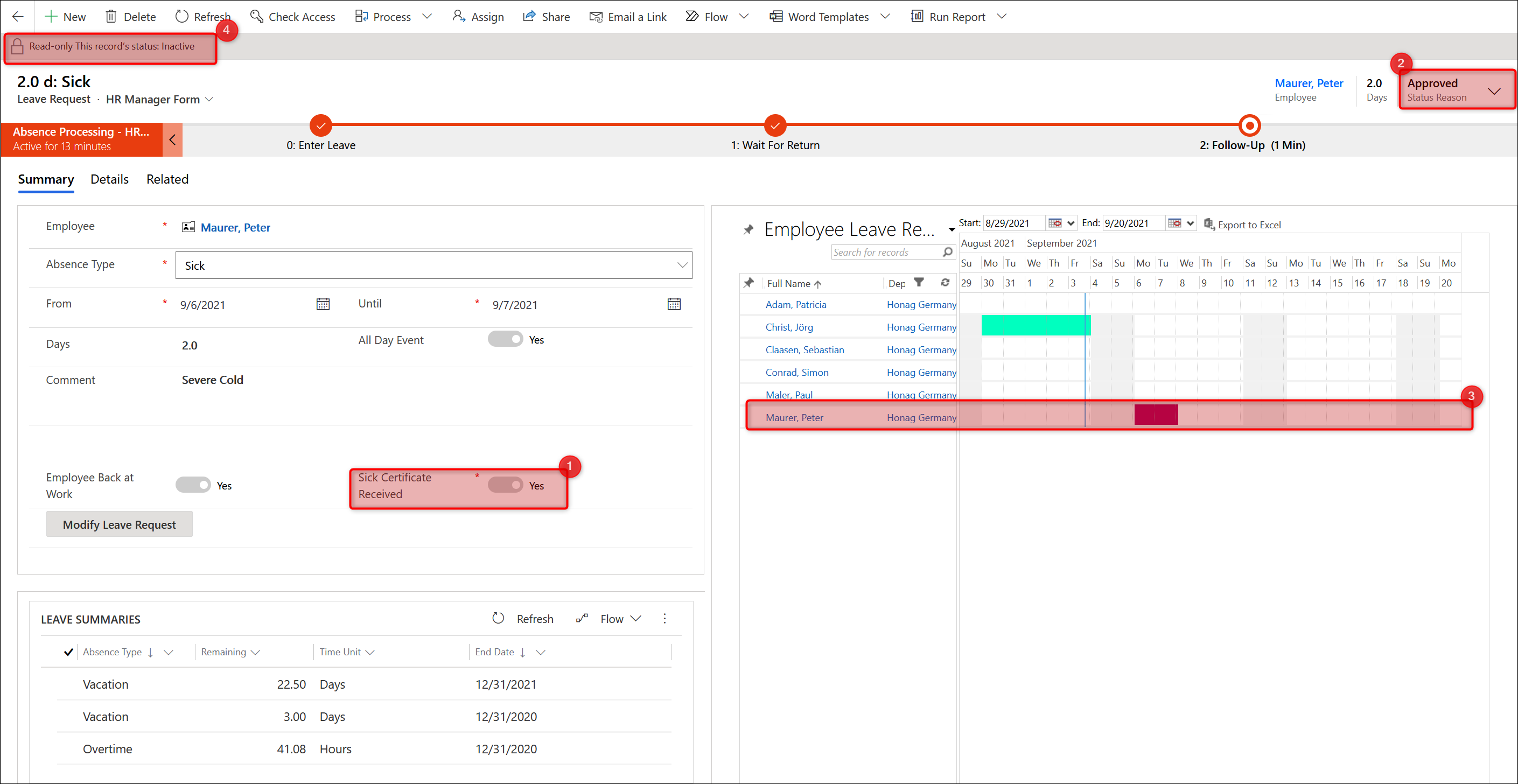
Back to top | Back to table of contents
7. Record Leave
A leave request can be entered by the HR manager as well as by the employee himself in the self-service. It is necessary to enter the leave request by the HR manager, if for example the employee is part of the staff but does not have hist own access to the system. However, the preferred approach is for employees to request their own leave request without HR manager intervention.
Note: This section is about entering a leave request from the HR manager's point of view!
For more information about Employee Self-Service please visit the following page: Employee Self-Service
In Dynamics HR Management, two leave request processes are available out-of-the-box: Leave request with substitute or leave request without substitute.
Which of these processes is used as the default in your company is up to you. As an HR manager, you can also change the process during the creation of a leave request - however, only the process defined in the standard is available to the employees.
Note: Both processes are available in parallel. For each new leave request, either one or the other process can be selected.
However, companies often use only one of the two leave processes. Therefore, simply deactivate the process that is not required to avoid confusion.
Enter a Leave Request without a Substitute
Navigate to HR Hub - Employees and open the digital personnel file of the employee for whom you want to enter a leave request.
Open the tab "Leave & Absence" and click on "New Leave Request" in the section Leave Requests.
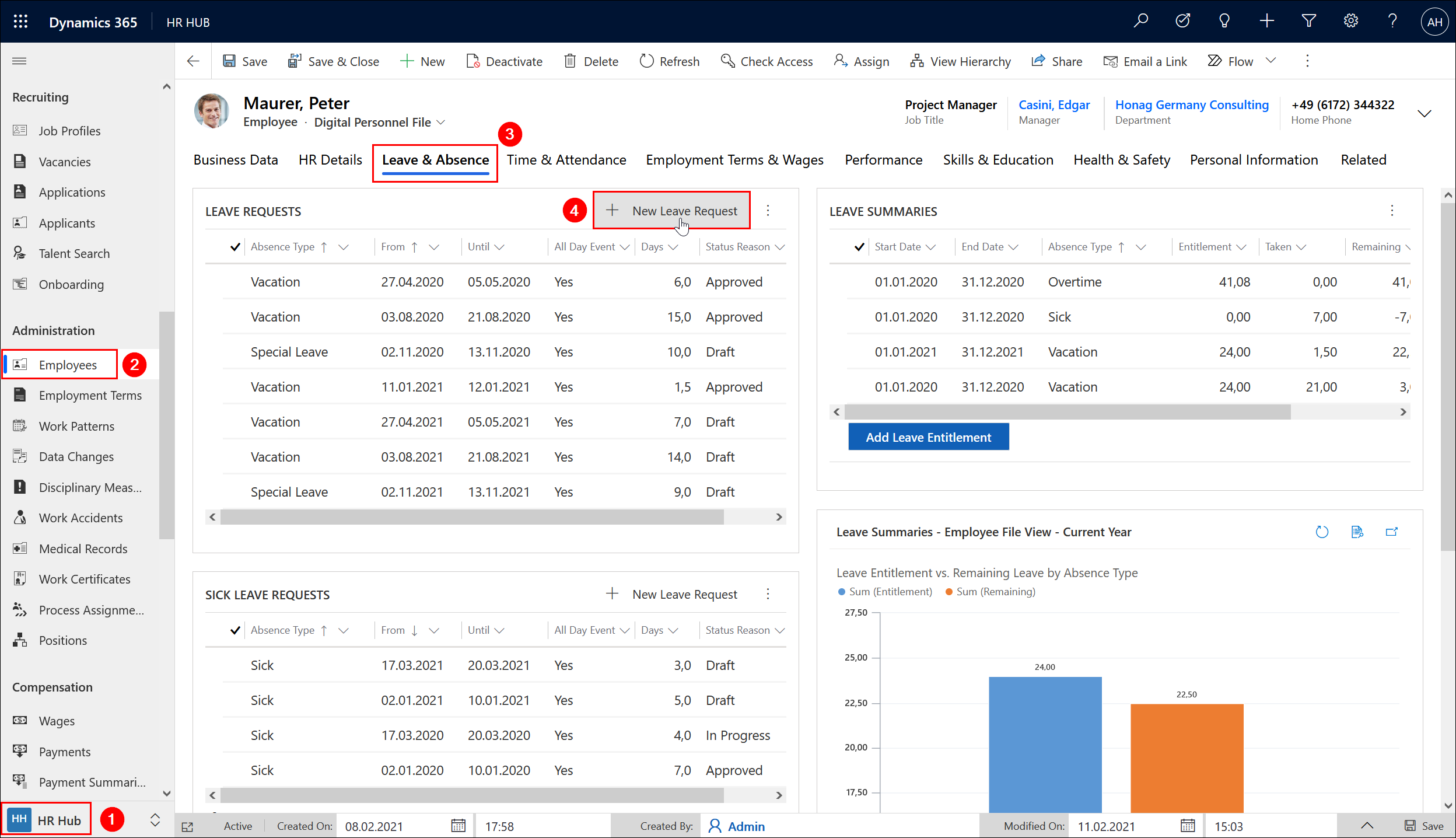
Choose Vacation as "Absence Type" and fill the fields From (start date) and Until (end date) of the leave request. Select if it is an "All Day Event" or not. If it is not an all-day event, you can choose whether the leave should start on the beginning of the second half of the day or ends after the first half of the last day. Depending on this, only half a day will be deducted from the leave entitlement of the employee. Optionally, you can add a comment to this leave request.
Save your entries and click on the button Submit.
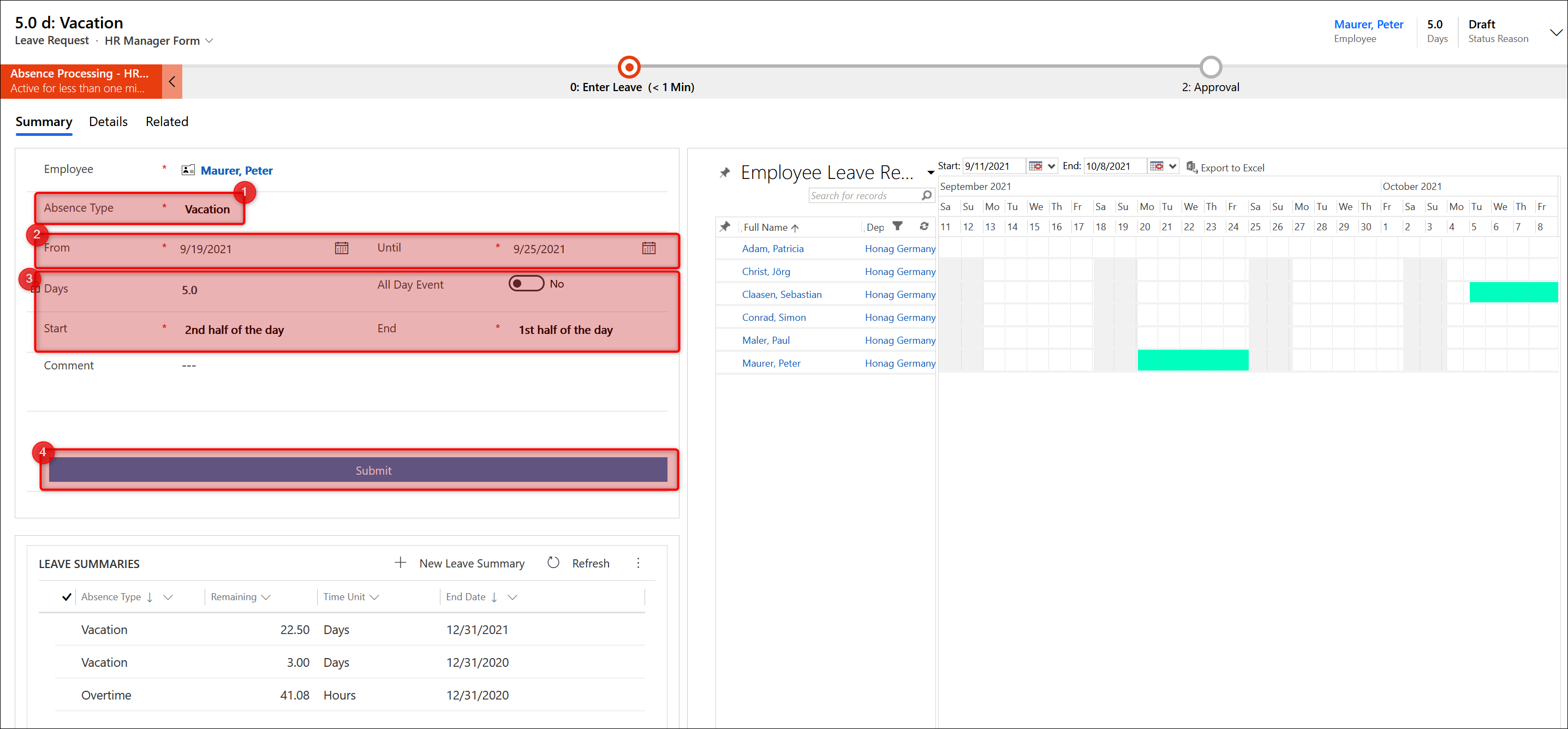
The total duration of the leave is calculated during the saving process. Please note, that the calculation of the required leave days depends on the employee's Calendar. For example, weekends or regional holidays are only taken into account if they are entered in the corresponding Calendar.
In addition, the absence calendar is displayed, in which you can see the current leave draft as well as the department-wide absences. This enabled to estimate at a glance whether the leave could lead to capacity bottlenecks in the department.
Click on Submit.
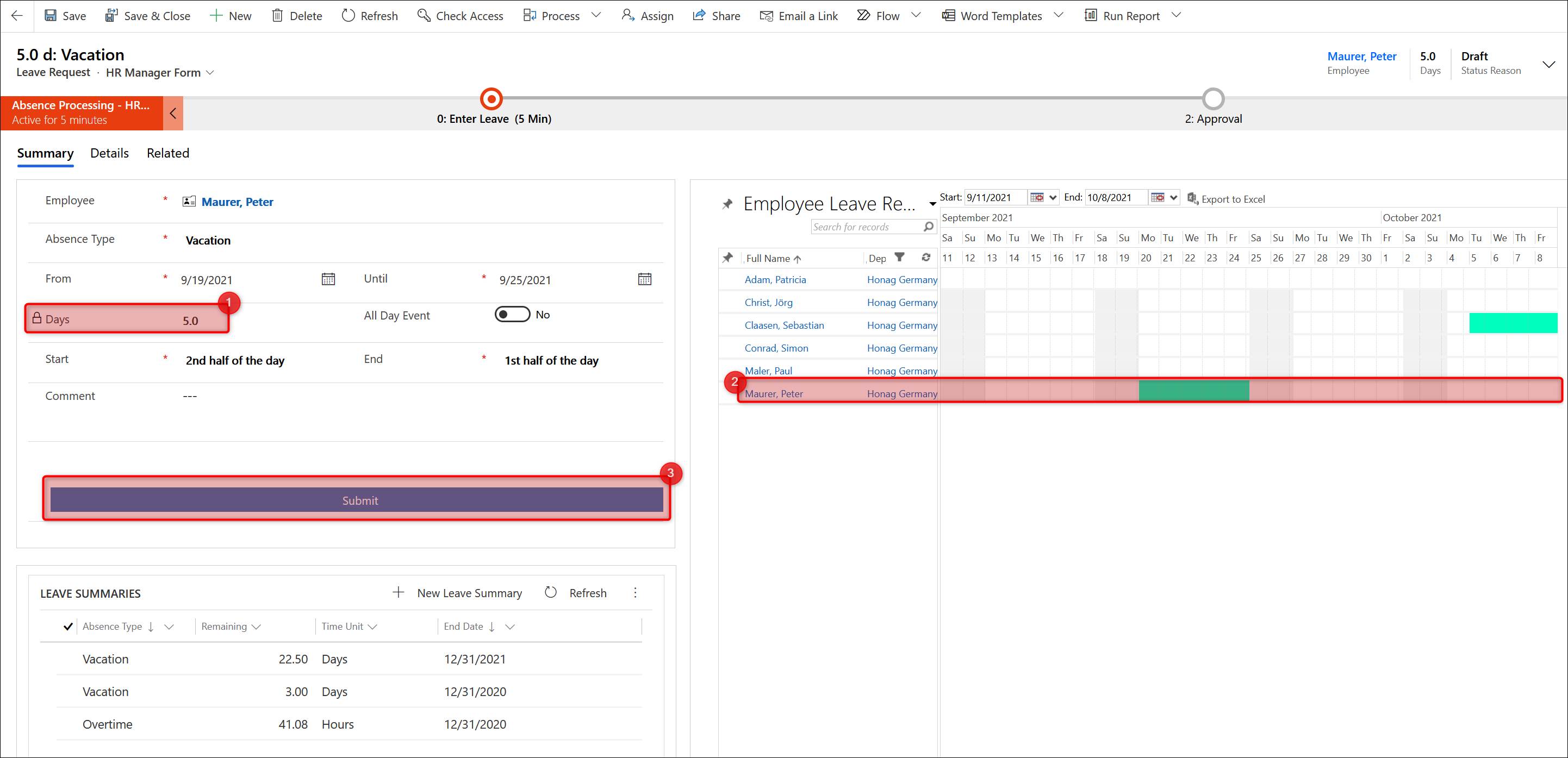
The transition to the next phase automatically triggers an information process for the supervisor. The supervisor now automatically receives an email informing him that one of his employees has requested a leave. The e-mail also contains a link to the leave request.
The leave request also appears in the supervisor's dashboard and in the HR deadline dashboard. This ensures that the supervisor is informed even if he has not read his emails and the HR manager can send reminders or take decisive action himself if decisions are pending for a long time.
If the supervisor clicks on the link in the e-mail, he is taken directly to the application, which he can review. Here he can find all the information at a glance, like when is the vacation, how long will it last and what's the department's staffing level at that time.
The supervisor now can make a decision and enter it into the system. If the request is approved, click on Finish and thus concludes the process. If you decide not to approve the request, you must justify this in the field "Reason for Rejection" that appears before you can click on Save.
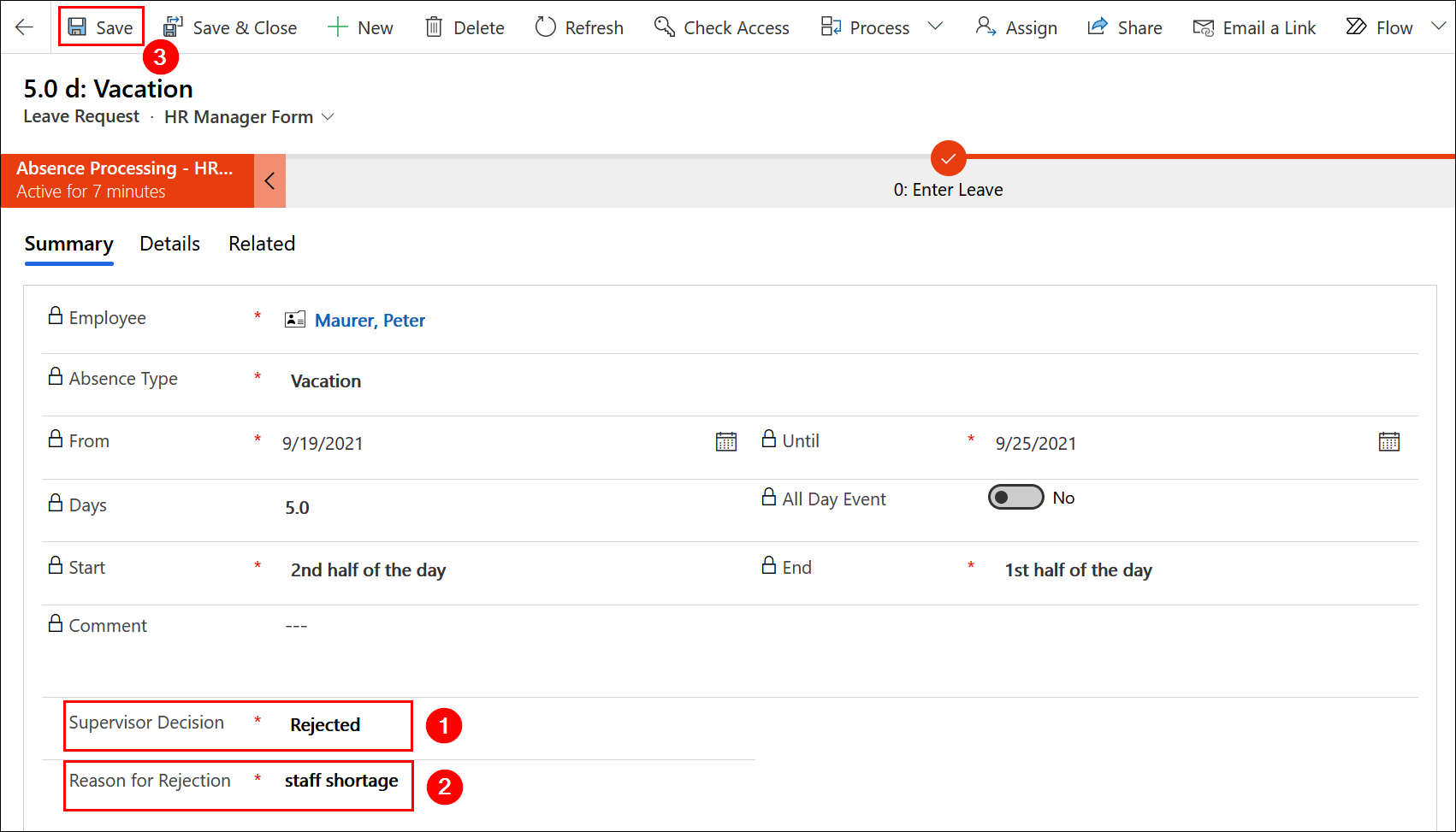
Note: The request can also be approved by the HR manager. This ensures that requests can also be processed if a supervisor is not available.
When the process is completed, an information process is automatically triggered again. This time, the employee receives an e-mail informing of the outcome of the decision on his leave request.
Enter a Leave Request with a Substitute
Out-of-the-box, the leave request process is opened without substitute. After the first saving, the process can be changed. First, fill in everything as in the leave request without a substitute and save the request.
Now click on "Process" in the menu bar an select "Switch Process".
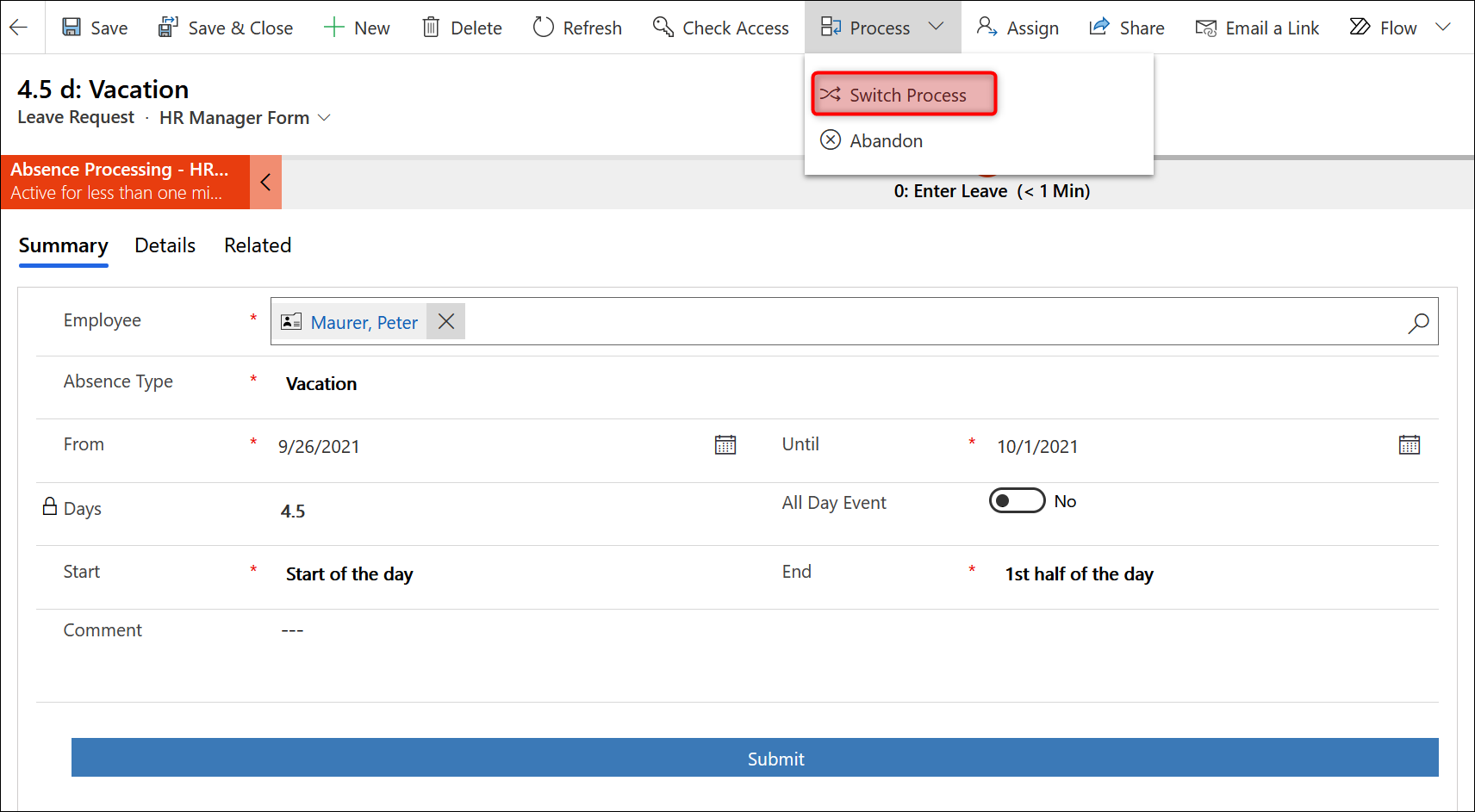
Select Absence Processing with Substitute - HR Management - xRM1 and confirm with OK.
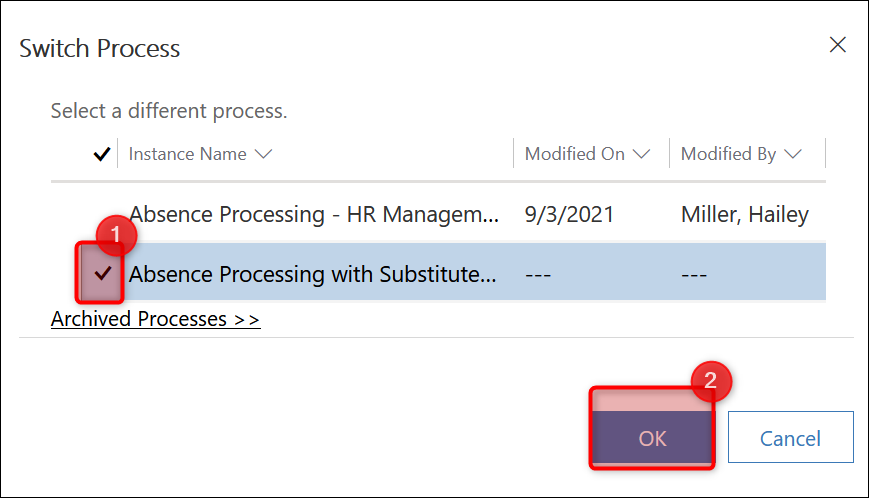
An additional phase is added: Approval Substitute.
You now need to select a Substitute before you can go to the next phase by clicking on Submit.
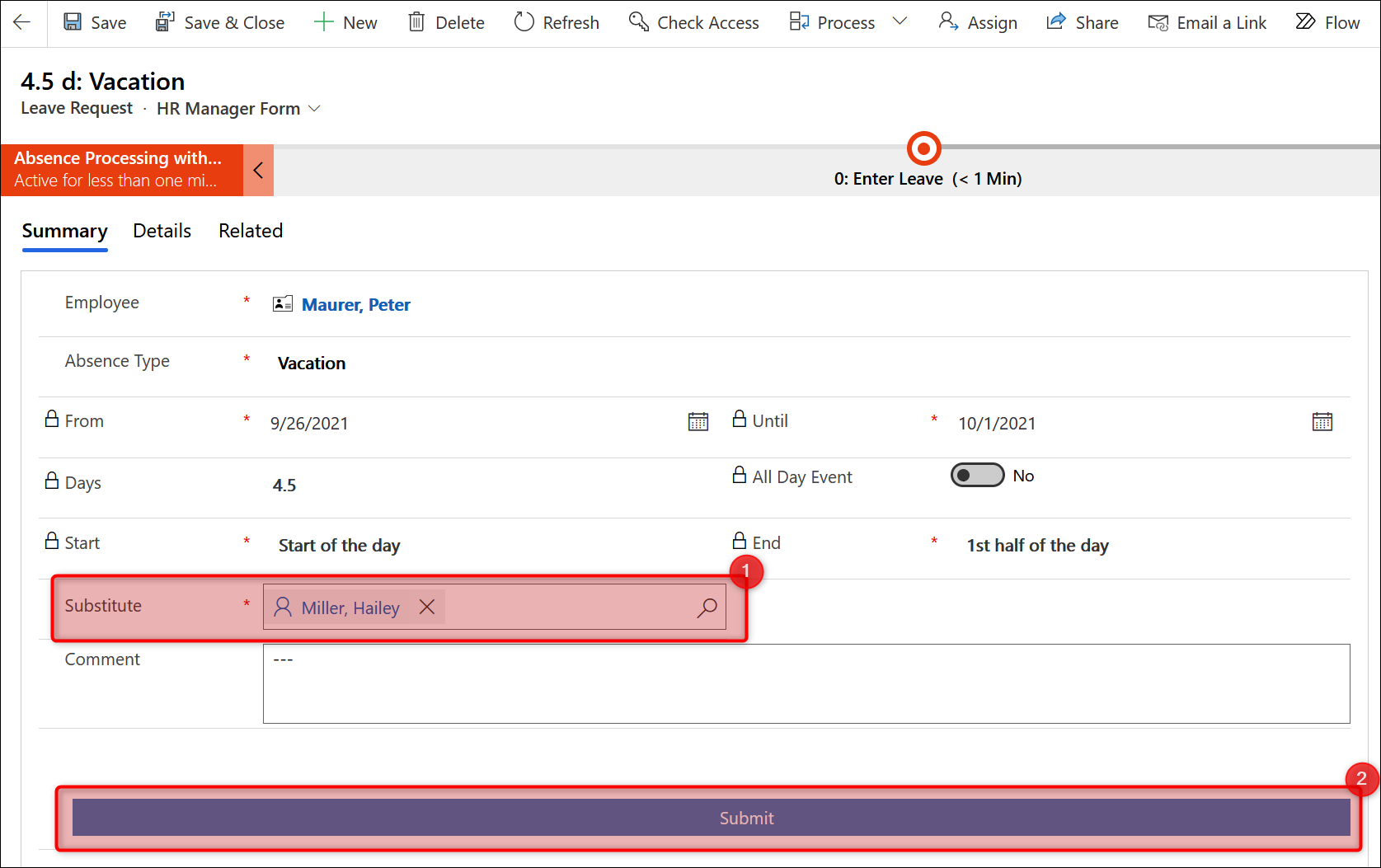
An automatic information process is triggered, which sends an email to the substitute informing of the request. By clicking on the link contained in the email, the defined substitute is taken directly to the request and can accept or reject the substitution.
By accepting, the rest of the application process is the same as the process without a substitute. The supervisor is informed with the request for approval. The employee is then informed about the decision.
Back to top | Back to table of contents
8. Modification of a Leave Request
As soon as the absence process is completed, the record is given the status "Approved" and is write-protected to exclude subsequent changes. This applies to both vacation and sick leave.
In practice, however, vacations that have already been approved may have to be postponed, or employees may get sick while already on vacation.
For such cases, the HR manager has the option to change leave requests that have already been completed.
You can change leave requests either via the Leave Summaries (HR Hub - Leave Summaries) or directly in the digital personnel file of the employee (HR Hub - Employees - Leave & Absence).
Double-click to open the leave request you want to edit.
Click on the "Modify Leave Request" button under the "Modification of Leave Request" area on the right.

A dialog opens. Select which action you would like to perform:
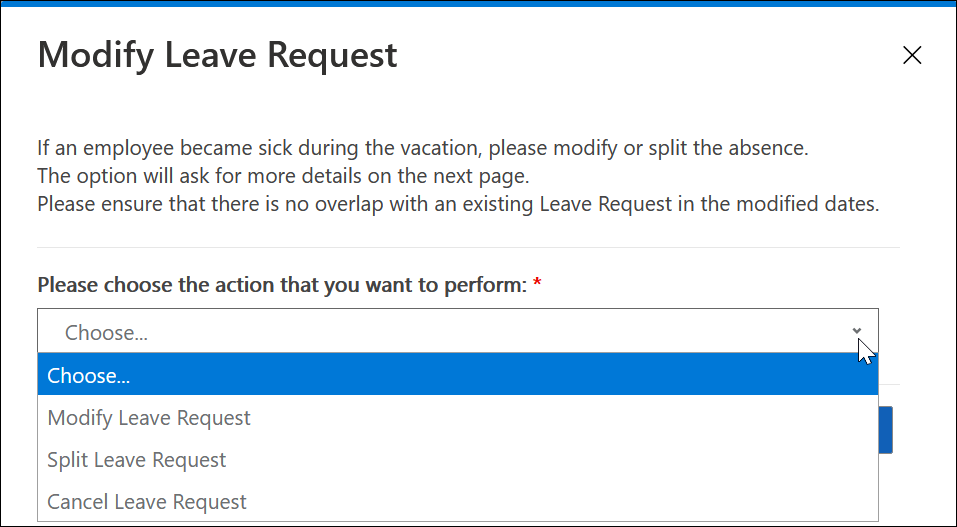
Modify Leave Request
When changing the time duration of the leave request, please select the option "Modify Leave Request" and click Next. Update the date values and check whether the leave request starts/ends in the first half of the day or at the end of the day.
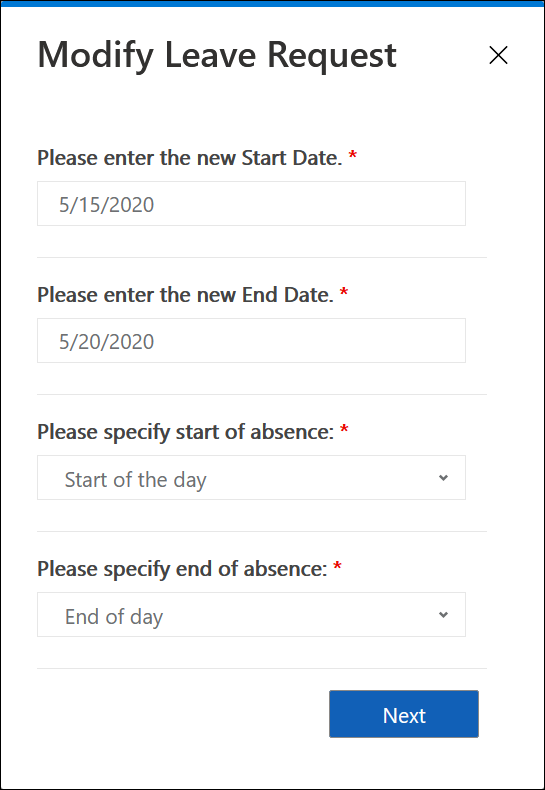
After you have made the changes, click Next. The leave request is now updated.
Split Leave Request
If an employee gets sick during his or her leave, you can split the leave request. To do this, select the option "Split Leave Request" and click Next. Specify the absence type, as well as the end date, for the first half of the absence and then the absence type for the second half of the absence.
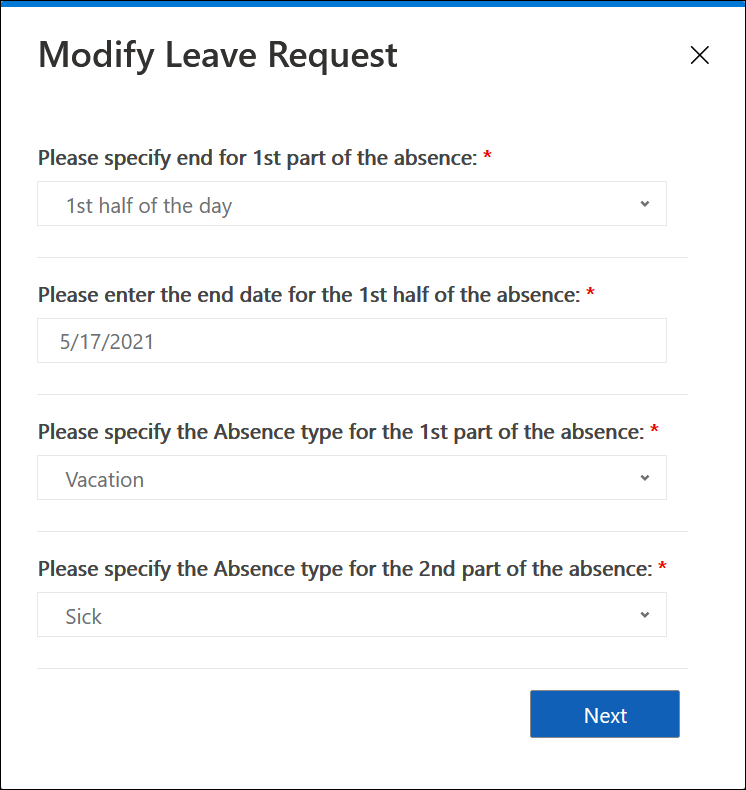
After you have made the changes, click Next. The leave request is now updated. The leave overviews of the absences have been adjusted accordingly.
Cancel Leave Request
If you want to cancel an approved leave request, select the option "Cancel Leave Request" and click Next. Enter a reason for canceling the leave request, and then click on Next.
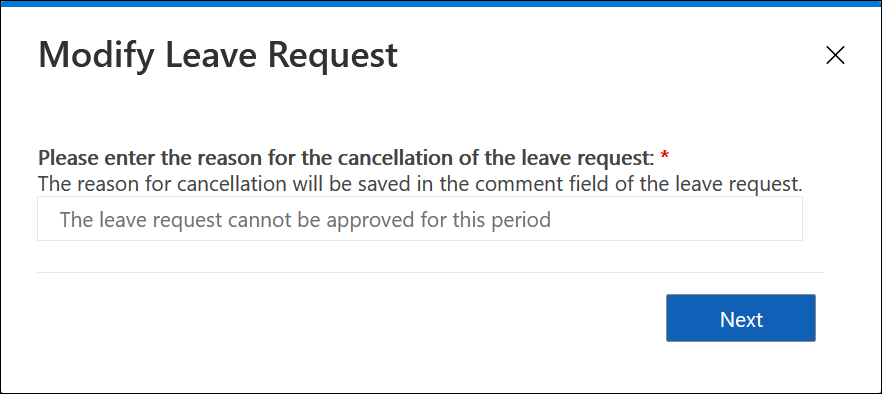
The leave request has now been canceled without any replacement.
Back to top | Back to table of contents
9. Business Closures
Dynamics HR Management offers a simple way to roll out business closures. Thereby, you can decide whether these should apply to the entire company, to certain departments or only to certain persons.
It is basically a leave request which you create for the selected group of people that is approved automatically.
Note: The duration of the business closure is deducted from the leave entitlement of the respective employees.
To roll out business closures, navigate to HR Hub - Business Closures and add a new record by clicking New.

In the "Summary" tab, enter a meaningful name and specify the period of the business closure. Using the "All Day Event" option, you can control whether it is a full day event or whether it affects only half a day. If it is not a full-day event, the part of the first, as well as the last day has to be defined. Optionally, add a comment to it.
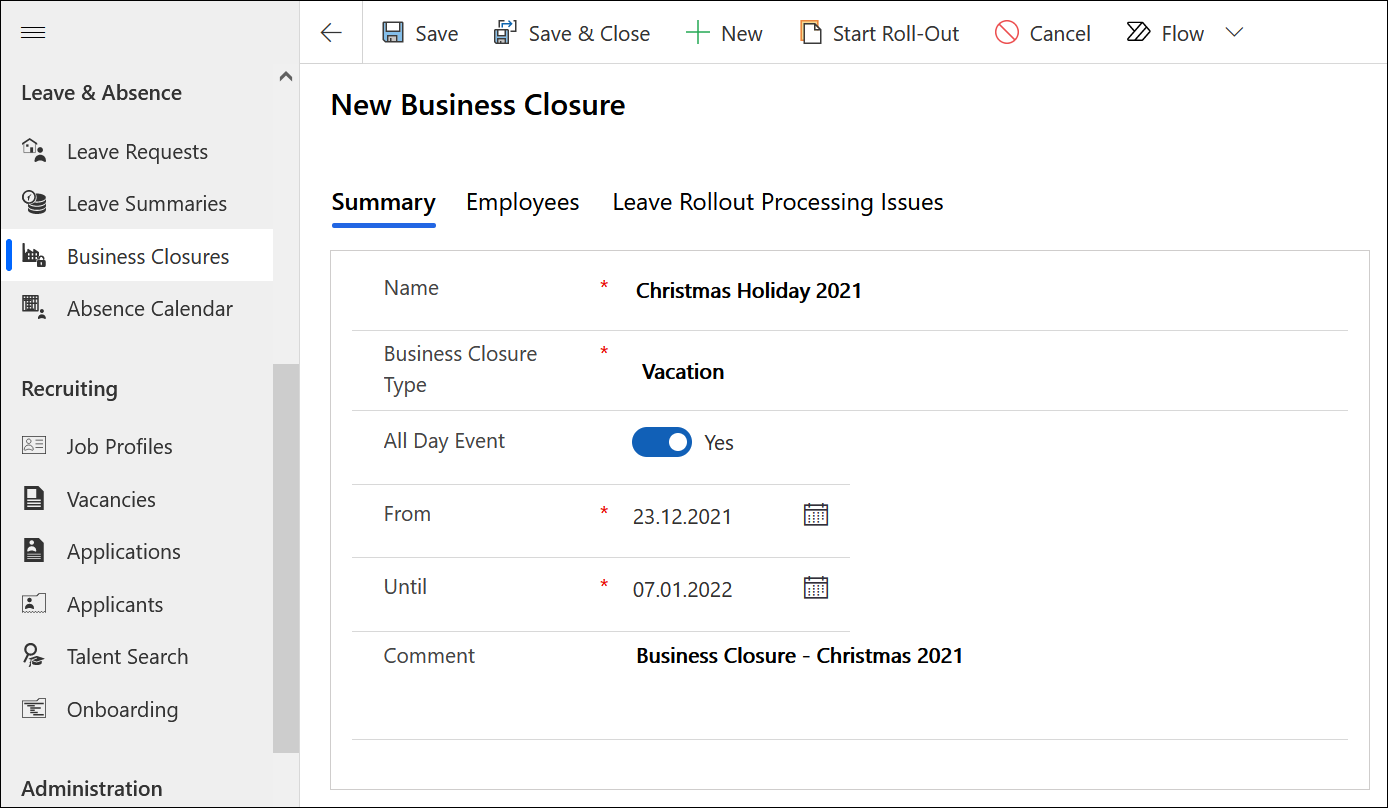
Save your entries.
Now you can either add the business closure for entire departments or for individual employees.
A combination of both variants is also possible.
1. Roll out Business Closures for Departments
After saving, another area "Affected Departments" appears in the "Summary" tab, where you can now add the departments that are affected by the business closure.
To do this, click on the three dots at the top right and then on "Add Existing Department".
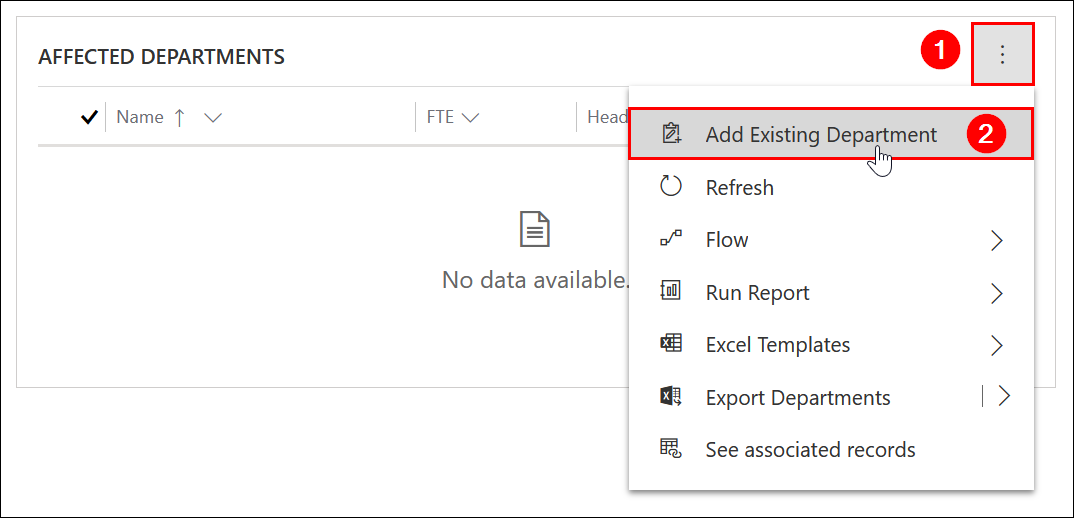
Now select the departments and click on "Add". The selected departments will then appear in the area of the affected departments.
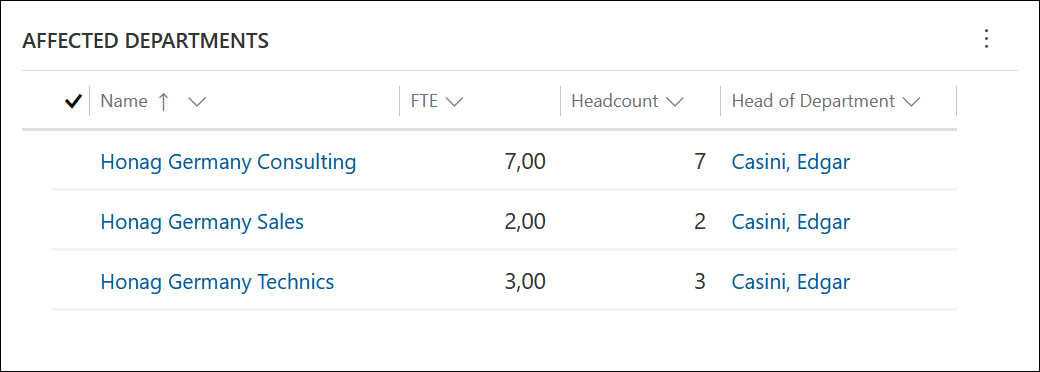
If you do not want to roll out the business closure for individual employees, you can skip the next step.
2. Roll out Business Closures for individual Employees
If you want to roll out the business closure for individual employees, switch to the "Employees" tab (to the right of the "Summary" tab). Now click on "Add Existing Employee".

Now select the relevant employees and click on "Add". The selected employees will then appear in the overview.

After you have added the departments or employees for which you want to roll out the business closure, you can start rolling out the business closure. To do this, click on "Start Roll-Out" in the menu bar at the top.

The business closure is now rolled out for all selected employees.
In the tab "Leave Rollout Processing Issues" you get an overview if there were issues with the rollout for the departments or employees. During creation, this section is always empty.
Back to top | Back to table of contents
10. Leave block
In Dynamics HR Management, you have the possibility to enter special workdays such as strategy planning weeks or a leave block in the absence calendar. To enter such a special workday in the calendar, an appointment needs to be created for the employee.
To do this, navigate to HR Hub - Activities and click on "Appointment" in the menu bar.
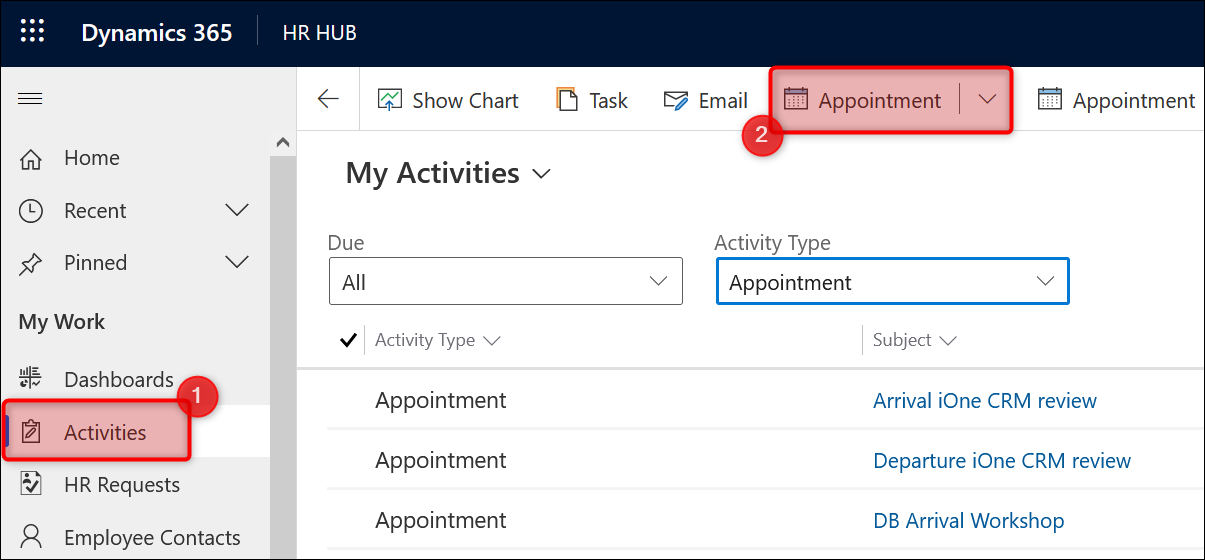
In the creation of a new appointment, enter a subject and select the relevant employee if required. Define the start and end time as you know it from Outlook and check the All Day Event box.
The appointment will appear in the absence calendar if it refers to the employee(s).
Save & Close the appointment.
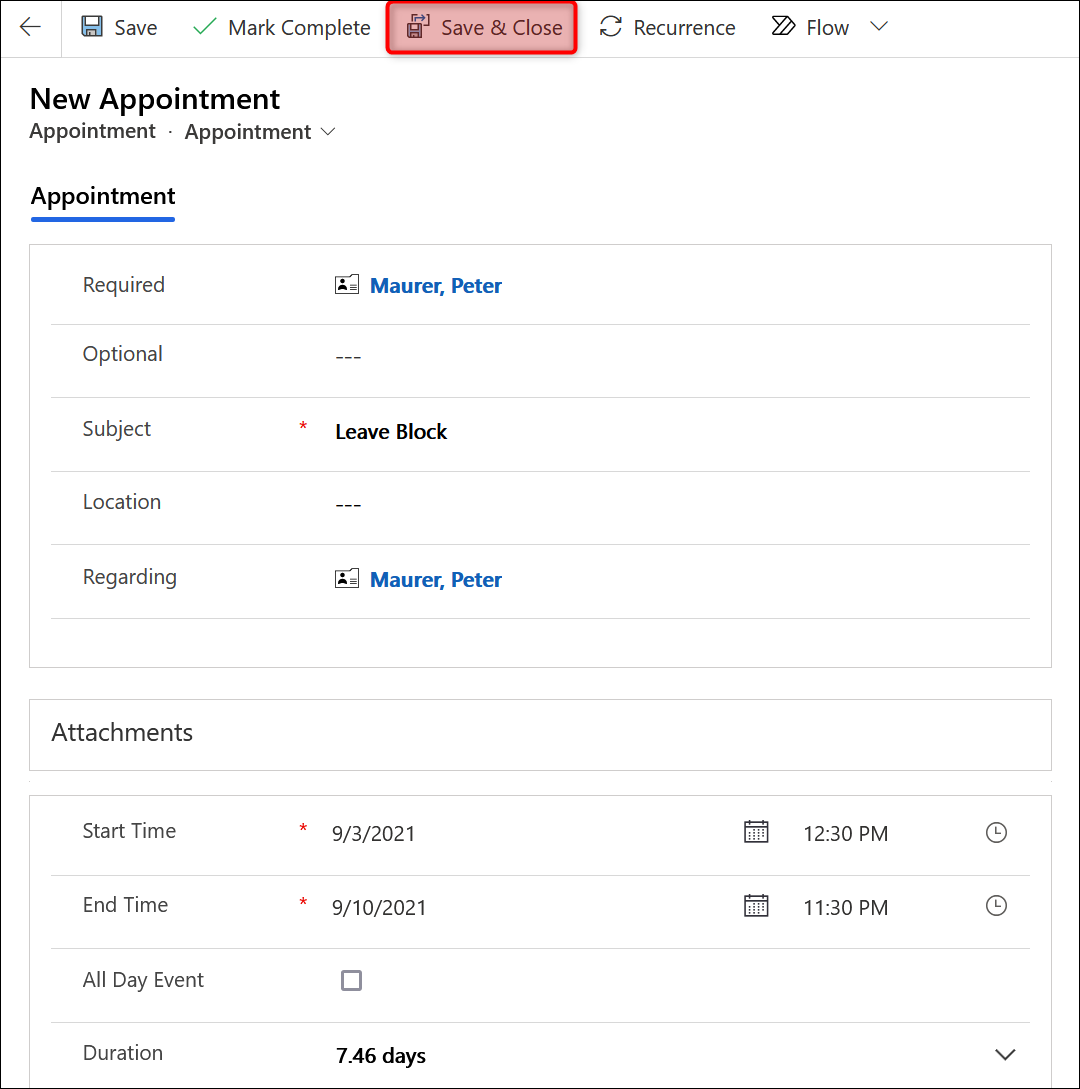
The leave block is now visible in the absence calendar.

Back to top | Back to table of contents
11. Automation
The absence processes in Dynamics HR Management are accompanied and supported by various activities. During the approval or documentation process, emails are sent and appointments and tasks are created in Microsoft Dynamics and Outlook.
You can see an overview of the activities in the respective absence process here:
| Absence Type | Creator | Process | Result |
|---|---|---|---|
| Vacation | Employee Supervisor HR Manager |
Approval process with or without substitute | E-Mail: to substitute for approval E-Mail to supervisor for approval Status: Approved/rejected (read only) E-Mail to employee for information about approval/rejection Global absence calendar: New entry Outlook-Appointment: “Out of office” for Employee Outlook-Appointment: “Free” for substitute Tasks for Employee: for absences > 2 days |
| Overtime | HR Manager | Approval process with or without substitute | E-Mail: to substitute for approval E-Mail to supervisor for approval Status: Approved/rejected (read only) E-Mail to employee for information about approval/rejection Outlook-Appointment: “Out of office” for Employee Outlook-Appointment: “Free” for substitute Tasks for Employee: for absences > 2 days |
| Special Leave Unpaid Leave | |||
| Sick / Work Accident | HR Manager | Waiting for return or waiting for sick certificate | Global absence calendar: New entry Status: Approved (read only) Outlook-Appointment: “Out of office” for Employee Sick certificate: for duration > 1 day |
| Sick Child | |||
| Unexcused Absence | |||
| Maternity / Parental Leave | HR Manager | Waiting for documents | Global absence calendar: New entry Outlook-Appointment: “Out of office” for Employee Status: Approved |
| Business Closure | HR Manager | Rollout of business closure | Status: Approved (read only) Outlook-Appointment: “Out of office” for Employee Tasks for Employee: for absences > 2 days |
